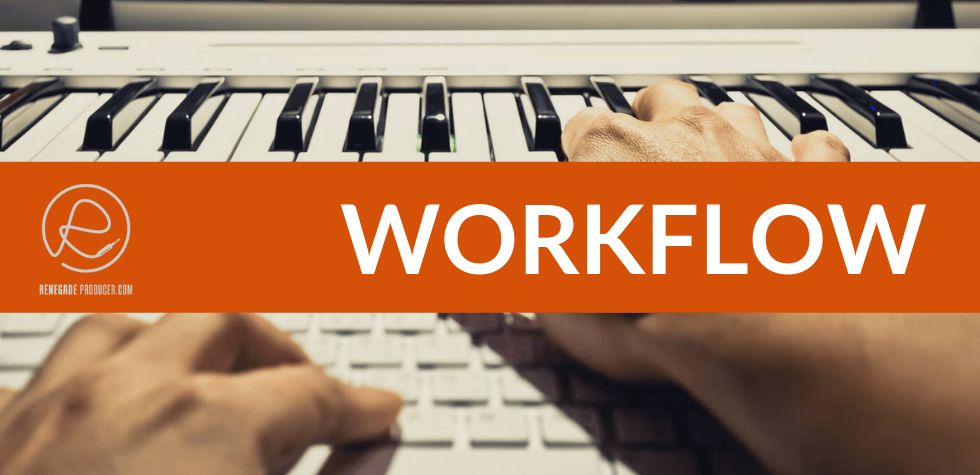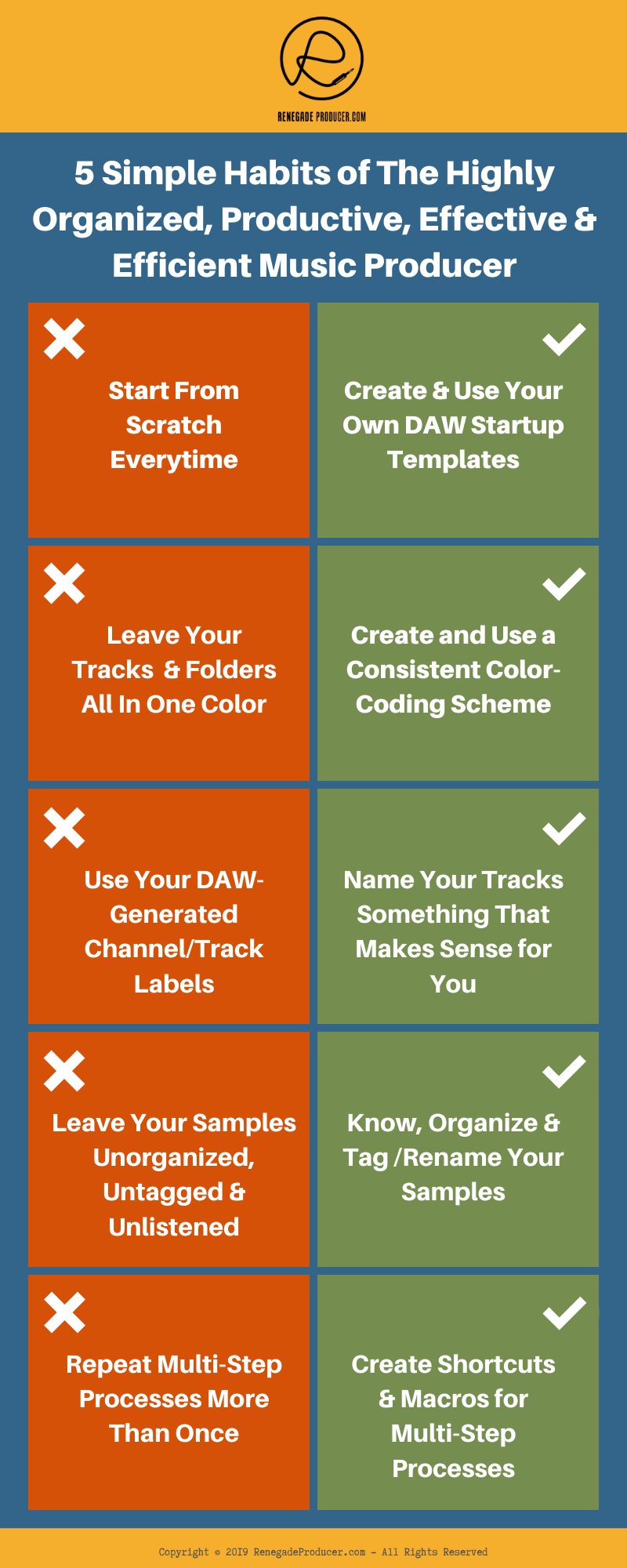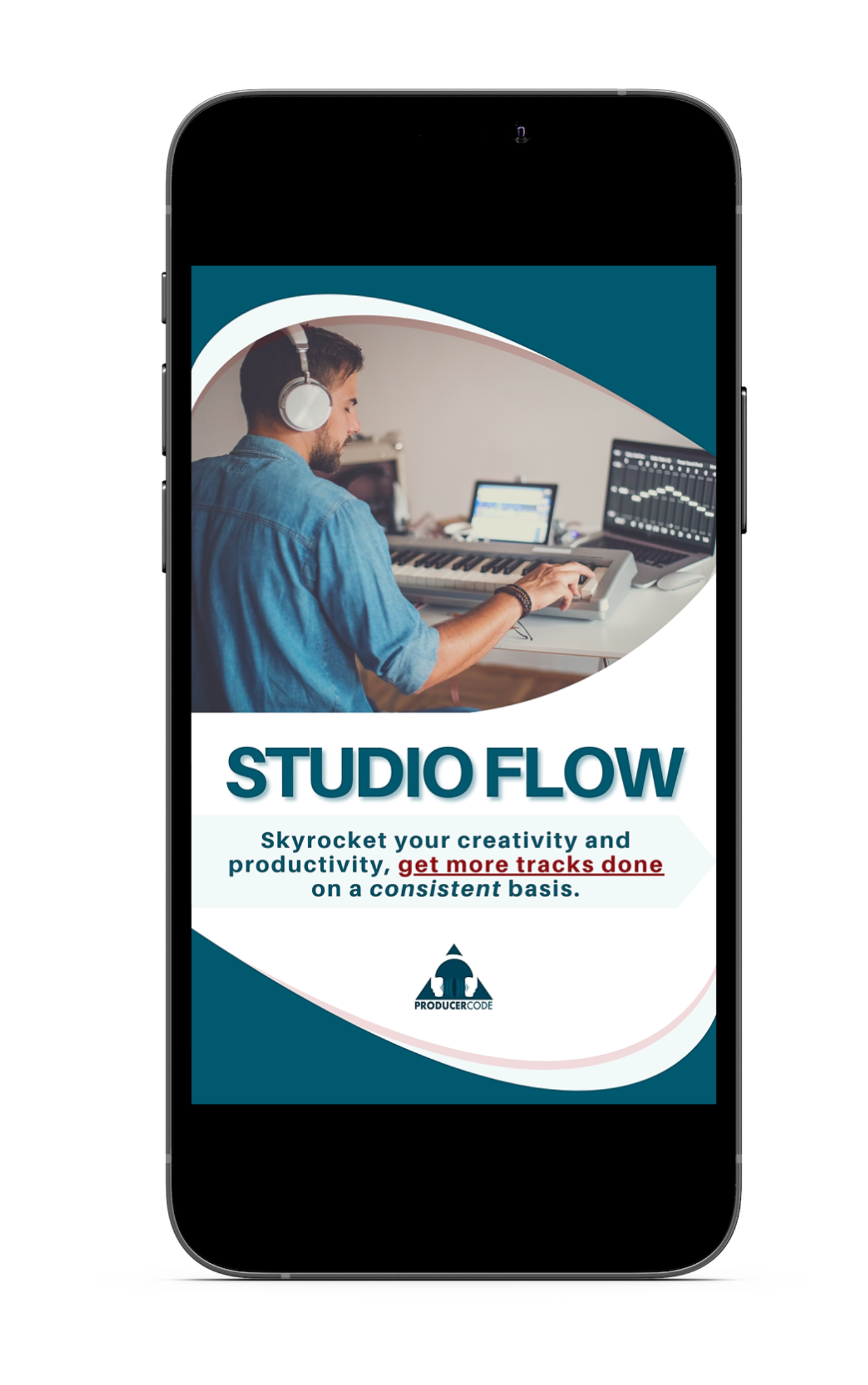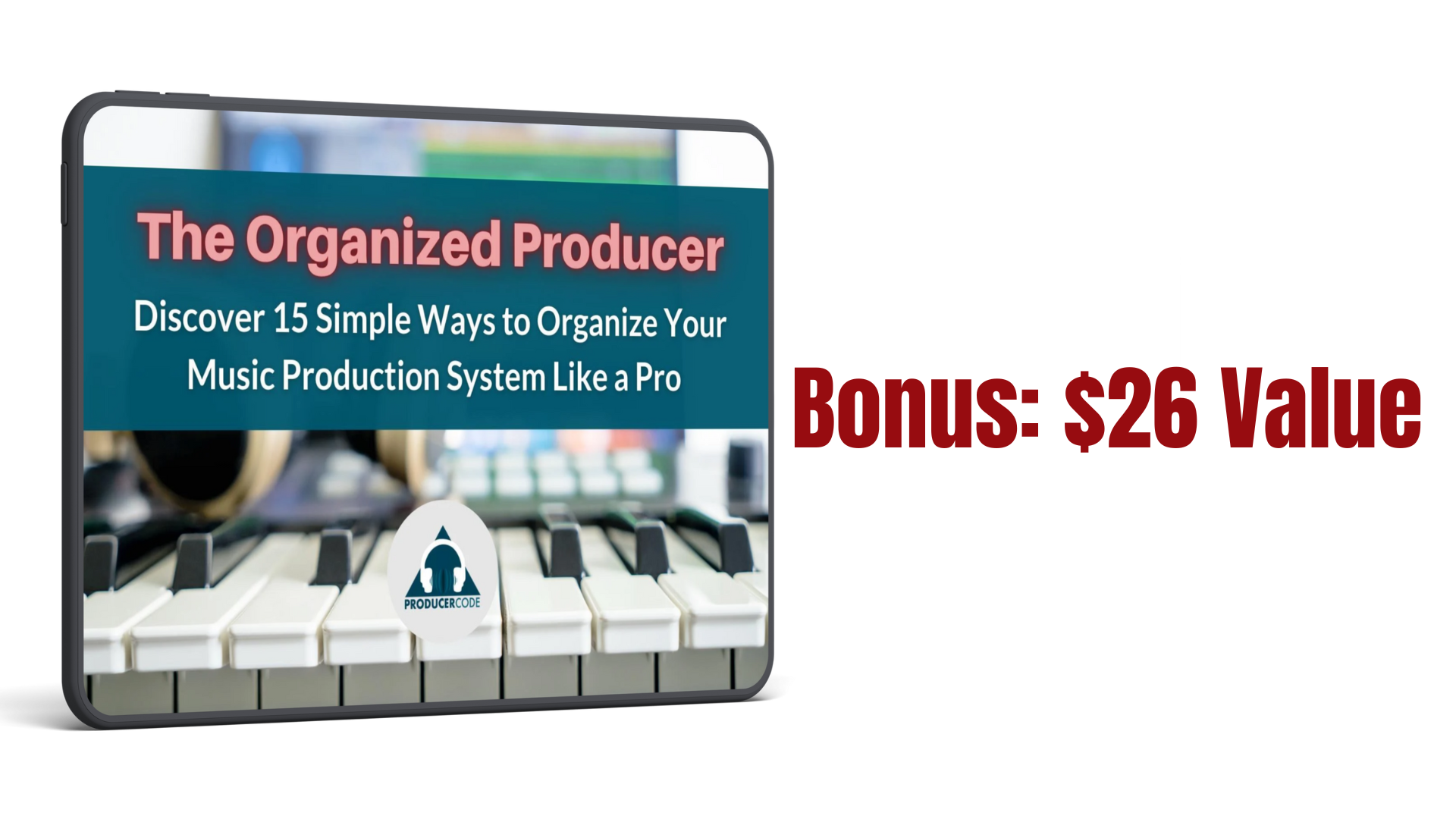"My Music Production Workflow Sucks! I Just Can't Get Myself Produce New Tracks as Fast and Often as I Want To. Sometimes I Feel I Should Just Give Up..."

What is a music production workflow?
You can see your music production workflow as the way you get music done. Or, you can see it as the processes involved in going from nothing to a finished track.
Every producer will have a different workflow in spite of the fact that we all pass through similar stages when make music and perform similar smaller activities during the process.
Where we start, how we proceed and how we finish can and does differ dramatically from one producer to the next.
When should you start to pay attention to your own music production workflow?
Beginner producers have a lot to learn about music production so it’s understandable that workflow isn’t at the top of the list of priorities for them. They have to first learn the basics of their DAW and how EQ, Compression, Reverb other processing works. In other words, building the right skill-stack is more important when you start out.
Once you have your basic music production skills you’ll get into the business of finishing tracks and, if you’re serious about your music, you’ll start to pay attention to the speed, effectiveness, efficiency and consistency of your creative output in the studio.
After you’ve finished 10-20 tracks you’ll have the ability to look at your own music production workflow and see how to best optimize it.
Why is it important to pay attention to your music production workflow?
Your workflow is important because it determines how much you’ll get done, how fast and often you’ll get it done and how consistent you’ll be in your output. It also can either help or hinder your progress as a producer because the better and more you work, the better you become and the more skills and experience you accumulate.
An optimized music production workflow will make it easier for you to get into the creative and productive headspace quicker, enter a state of flow, do the deep production work and get more quality tracks done, faster and on a consistent basis.
So, how do you optimize your music production workflow?
There are many ways to optimize the way you work and organize your life in such a way that you’ll produce faster, better and be consistent in your output.
The first thing to do however is to take a look at the way you currently finish tracks.
When do you work? How often do you produce and for how long? How do you tend to start tracks? What do you spend most time on when you produce? What are the actions you always take when you produce a track and in which order? How often do you currently finish new tracks?
The answers to the above questions will give you a basic understanding of your current music production workflow so you can start to think about ways of optimizing it for better results.
What do we producers need in place to have a supersonic workflow in the home studio?
I’ve spent a lot of time pondering the above question. Maybe a bit too much! ;-)
It’s now clear to me that there are 4 main aspects to consider if you want to produce new tracks faster and on a consistent basis. These are:
- Physical: This of course includes your studio space, your gear, your instruments, your studio furniture and your software tools. It also includes your own body because it’s easier to work well in the studio when you’re in decent shape and have good health and energy-levels.
- Mental: This refers to the knowledge, skills, theory and techniques you learn and apply to your craft as a producer. It also involves making decisions and problem solving your day-to-day work and practice in the studio.
- Emotional: Music is first and foremost about feelings. The rest of the process is all about capturing and presenting the music in such a way that it best invokes the emotion we want in the listener. As a producer it helps to be in a good place emotionally too. That said, a professional will work even when they may not feel to great.
- Creative: The slightly more mysterious aspect of the craft. Creativity is as you probably know by now your bread and butter as a music producer.
So, if you want to engineer a music production workflow that ensures optimal output then it helps to pay attention to how you work in each of the above aspects.
The whole idea is to create a balance that allows you to enter into a productive creative state in your studio on a regular basis. This can be a fragile balance to maintain. It pays to make it as anti-fragile as possible.
Ask yourself how you approach your own music production through the lens of each of the 4 aspects. Think about it. Write it down. Make a plan to step up your game.
You may discover that you could work much faster with a small change or two in your studio setup. You could uncover that you let your emotions get in the way of spending more time in the studio. You might realize that you lack a certain skill-set or some production knowledge. It may be that you don’t allow yourself enough time to get into a creative state in the studio.
Figure out where where you can make even tiny changes to your workflow. Tiny changes add up to make a huge difference to your creative output.
The main thing is to create a synergy and balance between these 4 aspects that results in the optimum level of creative output for you. Every producer is unique so the best workflow for you will be different from person to person.
What matters most is that you find a balance that works for you. You will know it works when you see the results you want!
Meet Resistance, The Mother of All Music Production Workflow Arch-Enemies...
Your main enemy as a music producer is always Resistance. Resistance is an ever-present force that wants nothing more than for things to remain the way they are. It resists change wherever change wants to happen. This means we face Resistance whenever we want to learn or produce something new.
Resistance is f@£!& insidious. It will use whatever technique it has available, and it has many available, to stop change dead in it's tracks. It will use your own thoughts and doubts. It will take advantage of your tiredness. It will use all types of distractions, including even your own friends and family.
It's not personal. That's just what Resistance does. It does anything it can to stop your productions.
You have to overcome it by any means necessary if you plan to produce like a pro.
"What Happens If I Don't Beat Resistance?"
Nothing happens.
You may however start to get frustrated. You may become unhappy and bummed out.
You may see your peers produce album upon album while you struggle to finish your first EP.
You'll make music only when you're inspired and rarely feel inspired. So, you'll make less and less music.
Resistance, will have you by the short and curlies.
Does it sound like I speak from experience? Damn right I do!
Resistance has kicked my ass for months on end at times. Netflix, Youtube and Social Media takes over. Works for while.
Then, bleakness sets in and you realize that constant consumption doesn't satisfy.
You discover that if you don't produce you resign yourself to a life void of fulfillment, excitement and achievement.
So, you wake up and decide to do something about it.
"How Do I Beat Resistance?"
That's easy! You sit down and do the work. Every. Day.
It's also easier said than done as you probably know well by now.
To beat Resistance, that excruciating foe, you need more. You need D*A*S*H:

- Determination - Decide to produce on a consistent basis. Make a formal deal with yourself. Stick to it.
- Action - Nothing happens unless something moves. That something in this case is you.
- System - This includes everything you need to make music. Studio, gear, DAW, Folder, Libraries, Calendar, Notebook and anything else you need. All primed, tuned and and ready to go.
- Habits - You become what you repeatedly do. Want to be a prolific producer? Produce often!
5 Simple Habits of The Highly Organized, Productive, Effective & Efficient Music Producer
Music production, as you probably know by now, can become very complex, very fast. It stands to reason then that anything you can do to save time and work faster and more effectively will improve your workflow, productivity and creative output in your home studio.
The most important thing is to pay attention to your music production workflow and do what you can on a regular basis to improve it. Below you'll find 5 simple practices or habits you can implement today to start upgrading your own music production workflow and system to be more productive and creative:

Let's take a quick look at each of these habits...
1. Create & Use Your Own DAW Startup Templates
Your goal is to get into a creative flow state as easily as possible when you sit down to produce. So, you definitely don't want to set up your DAW project preferences, tracks, groups, routing, inserts and sends every time you start a new project. This would not only waste your time but also puts you in a technical/admin-type mindset which isn't the creative playful state you need for producing, especially when writing music.
This is why it's crucial to not only create your own basic DAW startup templates but also to refine and refresh your templates on a regular basis.
A good DAW startup template has the things you know for a fact you'll use ready to go. Nothing more, nothing less.
If you make your startup template to complex and crowded you'll negatively impact your music production workflow. Same goes if you make it too simple and need to set up stuff in every new session. So, it'll take some time to discover the right balance for your own startup templates, but once you get it honed in you'll find that you start and finish tracks much faster.
2. Create and Use a Consistent Color-Coding Scheme
Theres nothing worse than getting to the stage where you have 100+ channels in your project and they all have the same default color assigned by your DAW. This slows down your ability to quickly navigate to the tracks/parts you want to work on. Talk about a music production workflow killer!
Color-coding tracks and parts solves this issue because the different colors provide a visual que for our brains to easily navigate to the right place, faster.
It's best to create a color-coding scheme and stick to it from project to project rather than using different colors in every project. In other words, if you decide to have drums colored red and synths yellow then you want to have that the same in every project. In time you'll get accustomed to your scheme and associate the color with the channels, folders or parts.
3. Name Your Tracks Something That Makes Sense to You
Along the same lines as color-coding, it makes life a whole lot easier when you name your tracks descriptively rather than leaving them as MIDI 1, MIDI 2, Audio 1, Audio 2 or whatever your chosen DAW does by default. Again, this makes navigation easier and also makes life easier when you open the project after a while of not working on it.
Good track-naming habits also helps mix engineers and collaborators you might work with as they are able to know what's what in your session at a glance, without having to solo each track and label it themselves.
So, in short, it's not MIDI 1 or Audio 1. It's Sub or Lead Synth or Snare. Make it a habit!
4. Know, Organize & Tag /Rename Your Samples
We've all been there. We start producing music and one of the first things we do is begin to gather samples. From free music magazine samples to sample-pack giveaways and tasters to other producers sharing their own samples, it's a freaking sample-collecting rampage.
Before you know it you have a 100+GB folder of samples named "My Samples" or something to that effect with a chaotic mess of subfolders with a variety of sound packs.
Now, as you're probably well aware by now, this makes it hard to find the sound you want. You may have a nice selection of snares, but they're all over the place, spread between different packs in different folders. Not only does this slow down your music production workflow, it also means you may miss some samples just because you don't go through certain folders when you hunt for a sound.
A much better way is to go through your samples and place them in a folder system that makes sense.
How you organize your samples will depend on how you like to work. You might have separate folders for different instruments like Kick, Bass, Snares, Hats, FX and Vocals. You may want to sub-sort tonal instruments by key. You may want to sort loops by BPM. Again, this is something you'll want plan out a bit and base your decisions on your own personal preferences.
Sorting a sample library, especially a huge one is no fun task. The massive improvement of your music production workflow once it's done is however what makes it well worth your time to do. The added benefit is that as you go through your samples systematically you'll discover great samples you've forgotten you have.
Don't be afraid to rename your samples as you go through them and/or tag your samples. This makes it easier to use your DAW media manager search function. I mean, isn't "WhiteNoiseSnare.wav" or "Distorted909Clap.wav" better than "Snare23.wav" and "Clap45.wav"?
5. Create Shortcuts & Macros for Multi-Step Processes
When you start out it may be easier to open a menu, then a sub-menu, then another sub-menu and then click on the function you want, rather than memorizing shortcut hotkeys. A shortcut could however reduce the same 4 steps to 1 or 2 steps. Sounds like nothing but if you count the amount of time you waste over a few years you might be gobsmacked at the result.
So, of course you want to learn and customize your shortcuts. You can even take it further and learn how to create macros that complete multiple functions with 1 or 2 keystrokes.
In short, if you do any multi-step process more than once then you should see if there's a way you could create a shorcut or macro to make it faster and easier in future. The upfront time and effort pays huge dividends in the long run.
ProducerCode: Studio Flow is a solution to help you improve your music production workflow:

Inside, you'll:
- Uncover and beat your #1 enemy.
- Develop the right perspective, a mindset and outlook conducive to studio flow.
- Discover all the tips, insights, tricks and techniques that help you find your flow and increase your studio output.
- Make your music production workflow something you can rely on time and time again to deliver quality results.
- Feel fantastic when you start to crush it in your studio on a regular basis!
What is ProducerCode: Studio Flow?
ProducerCode: Studio Flow is a course with one goal...
... to help you produce more tracks on a consistent basis. You get...
- 27 insights and practical strategies and tips delivered in 45 mins of short rapid-fire videos all focused on helping you overcome blocks, beat Resistance and start to produce like a pro within weeks.
- A 5-week Action Plan with exercises designed to increase your creativity, productivity and totally destroy all self-imposed obstacles in your way.
Don't delay. Level up your music production workflow today!
The entire first module of the course is free so you can check it out if it makes sense for you before you buy the course.
Update: New Bonus Course Added
You can now also activate free access to "The Organized Producer" course once you've completed "Studio Flow".

Share this post. Spread the knowledge so other producers can benefit too:
- Renegade Producer
- Producer Workflow Course
ⓘ Some pages contain affiliate links so I might earn a commission when you buy through my links. Thanks for your support! Learn more

